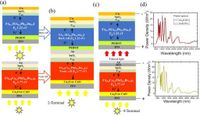In the quest for improved energy solutions, tandem solar cells have emerged as a beacon of hope, promising to exceed the efficiency limitations posed by traditional single-junction silicon cells. A recent study has delved deep into the utilization of copper oxide materials, specifically electrodeposited Cu2O and mixed phase Cu–O films, as hole transport layers (HTLs) in all-perovskite tandem solar cells. The results, presented by a team of researchers from the Vellore Institute of Technology, illustrate not only the feasibility of these materials but also their potential to enhance solar cell efficiency significantly.
The research indicates that the highest efficiency predicted for a two-terminal tandem device utilizing Cu2O-HTL reaches an impressive 24.95%, while the four-terminal tandem configuration could push this efficiency even further to a stunning 35%. This significant advancement could revolutionize the solar energy sector, where efficiency improvements are crucial for wide-scale adoption.
The rationale behind this investigation stems from the current limitations observed in commercially available HTLs. Materials like PEDOT:PSS, widely used in solar cells, tend to be expensive and complex to synthesize, often hampering large-scale production. In contrast, the study emphasizes the advantages posed by copper oxide HTLs, which combine lower costs with environmentally favorable characteristics.
The research methodology employed by the team involved synthesizing pure-phase Cu2O through an electrodeposition process and converting it into a mixed-phase Cu–O film via controlled annealing. This not only enhanced the material's properties but also provided a scalable production method suitable for commercialization. The researchers conducted detailed optical and electrical simulations using SCAPS-1D, a tool well-regarded for modeling solar cell performance, to predict and optimize device efficiency under realistic testing conditions.
Notably, the team reported that the certified power conversion efficiency (PCE) of existing perovskite/silicon and perovskite/CIGS tandem solar cells currently hovers at 34.6% and 24.2%, respectively. This highlights the significant competitive advantage new materials like Cu2O and Cu–O could deliver in the race towards achieving efficiency closer to the theoretical limits predicted for double (42%) and triple (49%) junction solar cells.
The optical properties of the Cu2O and Cu–O films were extensively characterized to assess their suitability as HTLs. The study revealed that the average visible light transmittance (AVT) for Cu2O films varied between 99.4% and 86.3%, demonstrating a high level of transparency necessary for effective solar energy capture. Moreover, the calculated bandgap energies of 2.53 eV for Cu2O and 2.23 eV for Cu–O support their roles as effective HTLs in controlling charge transport between layers within the solar cell structure.
Experimental results also indicated that the optimum electron affinity for Cu2O was identified at around 3.8 eV, enhancing the performance when interfacing with perovskite materials. This corresponds with findings from the simulation, which show that the power conversion efficiencies for varying device architectures were dependent on both the type of HTL used and the electron affinity levels implemented.
In the conclusion of the study, the authors assert that both Cu2O and Cu–O films exhibit great potential as environmentally friendly and economically viable HTLs for perovskite solar cells. This research marks a significant step forward in the development of more cost-effective solar energy technologies, emphasizing the need for further exploration and optimization in the journey toward sustainable energy solutions. The groundbreaking efficiencies achieved in simulations underscore the critical advancements that can be made with the adoption of innovative materials in photovoltaic devices.

